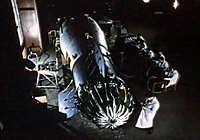 |
 On October 30, 1961, the most powerful weapon ever constructed by mankind was exploded over the island of Novaya Zemlya in the Arctic Sea. The device was code-named "Tsar", was a multi-stage hydrogen bomb which was built in only sixteen weeks by engineers in the USSR at the order of Soviet Premier Nikita Khrushchev. On October 30, 1961, the most powerful weapon ever constructed by mankind was exploded over the island of Novaya Zemlya in the Arctic Sea. The device was code-named "Tsar", was a multi-stage hydrogen bomb which was built in only sixteen weeks by engineers in the USSR at the order of Soviet Premier Nikita Khrushchev.
It was intended as a display of Soviet superiority during a period of grave tension between the USSR and the United States. The Russians had erected the Berlin wall only two months earlier, and they had just ended a shaky, three-year moratorium on atmospheric nuclear weapons testing. Before this, the largest explosion the world had seen was the 15 megaton shot Bravo during operation Castle in Frebruary 1954.The Tsar's explosion was over three times more powerful than this, despite the fact that the device was deliberately prevented from operating to its full potential.
The completed weapon weighed 27 metric tons, and though it was technically "aircraft-deliverable," it was too large to fit inside the bomb bay of the largest soviet bomber of that era, the Tu-95. Consequently the plane was specially modified, including the removal of the bomb bay doors to allow the bomb to protrude from the plane, and a coating of a special reflective paint to minimize the damage from the massive thermal pulse. It was also retarded by a huge 1,645 square meter parachute to give the bomber crew adequate time to get to a safe distance.
The fabrication was rushed, many calculations were skipped, and last minute modifications to the design were made. Facing the tight schedule, bomb assembly began even during design development.
 At 11:32am the weapon was dropped from an altitude of 10,500 meters over the Mityushikha Bay Nuclear Testing Range at Novaya Zemlya. The weapon's on-board barometric sensors detonated the bomb at approximately 3,900 meters. At 11:32am the weapon was dropped from an altitude of 10,500 meters over the Mityushikha Bay Nuclear Testing Range at Novaya Zemlya. The weapon's on-board barometric sensors detonated the bomb at approximately 3,900 meters.
One second after detonation, the fireball was over 6.5 kilometers wide. Despite the high altitude of the test, the fireball swelled down to the Earth’s surface almost licking the ground. The mushroom cloud which followed the blast stretched sixty kilometers into the sky, and had a diameter of about forty kilometers.
 Despite cloudy skies, the flash of light was clearly visible 2,500 kilometers away. The shockwave destroyed buildings and tore roofs off of homes hundreds of kilometers from ground zero. Windows in Norway and Finland were shattered. The scientific settelment on the Matochkin Strait called Severney, some 56 kilometers south of the explosion, was devastated. The thermal pulse of the blast was felt 800 kilometers from the epicenter. Radio communications were knocked out for an hour and no word of the safety of the Tu-95 and its crew could be reported for some time. Despite cloudy skies, the flash of light was clearly visible 2,500 kilometers away. The shockwave destroyed buildings and tore roofs off of homes hundreds of kilometers from ground zero. Windows in Norway and Finland were shattered. The scientific settelment on the Matochkin Strait called Severney, some 56 kilometers south of the explosion, was devastated. The thermal pulse of the blast was felt 800 kilometers from the epicenter. Radio communications were knocked out for an hour and no word of the safety of the Tu-95 and its crew could be reported for some time.
Some time after the explosion, a team was dispatched to ground zero to take photographs. One witness reported: "The ground surface of the island has been levelled, swept and licked so that it looks like a skating rink. The same goes for rocks. The snow has melted and their sides and edges are shiny. There is not a trace of unevenness in the ground… Everything in this area has been swept clean, scoured, melted and blown away." Analysis of the explosion showed that complete destruction extended to a radius of 40 miles surrounding the blast and severe damage as far as 60 miles.
Naturally, the United States was outraged, and responded by rattling its nuclear sabre in return. The U.S. soon followed suit with an extensive series of nuclear weapons tests.
The "Tsar Bomba" or "King of Bombs"– was originally designed to yield a 100 megaton explosion. However, the uranium tamper was replaced with a lead one, decreasing the yield to 50 megatons, this also eliminated much of the radioactive fallout generated by the test, and an almost certain doom for the release plane. The lead tamper also made the bomb the cleanest device ever made, with 97% of the yield coming from the fusion reaction. Even at the decreased yield, it was approximately 4000 times more powerful than the bomb which destroyed Hiroshima.
The truth was that even at half strength, Tsar was so powerful that it was essentially impractical. Much of the explosion's energy radiated upwards into space, and that which didn't was so excessive that using the device on any populated targets world would have resulted in adverse effects on Russian interests. Also the slow Tu-95 would have made an easy target for Western intercepter aircraft and air defences.

Panoramic view of ground zero after the explosion
|
|
|
 |





